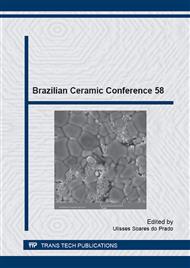p.213
p.218
p.225
p.231
p.239
p.244
p.250
p.256
p.262
Mechanical Properties Evaluation of Al2O3-YAG Ceramic Composites
Abstract:
Y3Al5O12 (YAG - Yttrium Aluminum Garnet) ceramic oxides has been widely used as a reinforcing phase to Al2O3 in order to achieve a composite with good mechanical properties. These factors are possible because the Al2O3 and YAG oxides possess thermal compatibility and high resistance to oxidation and corrosion, which makes your job quite attractive relative to other ceramics. This research was performed in two compositions, one in the eutectic composition with 63.65% Al2O3 and Y2O3 36.35wt.% and one with 80.00% of Al2O3 and 20.00wt.% of Y2O3. After milling for 2h, the powder mixtures were dried for 48h at 120°C. Mixtures were then comminuted by mortar and pestle and sieved using a 100 mesh sieve. The compositions were compacted uniaxially at 70MPa for 30s. The two mixtures were sintered at 1500°C or 1600°C for 3h. The samples were evaluated for hardness by Vickers indentation, fracture toughness by the indentation method (KIC) and Scanning Electron Microscopy (SEM). It was verified that the eutectic composition sintered at 1600°C-3h showed the highest hardness among the others, 10GPa, and a fracture toughness of 3.8MPa.m1/2, both consistent with the literature results. The SEM images showed a reduction in porosity with increasing of sintering temperature.
Info:
Periodical:
Pages:
239-243
Citation:
Online since:
June 2015
Authors:
Price:
Сopyright:
© 2015 Trans Tech Publications Ltd. All Rights Reserved
Share:
Citation:


